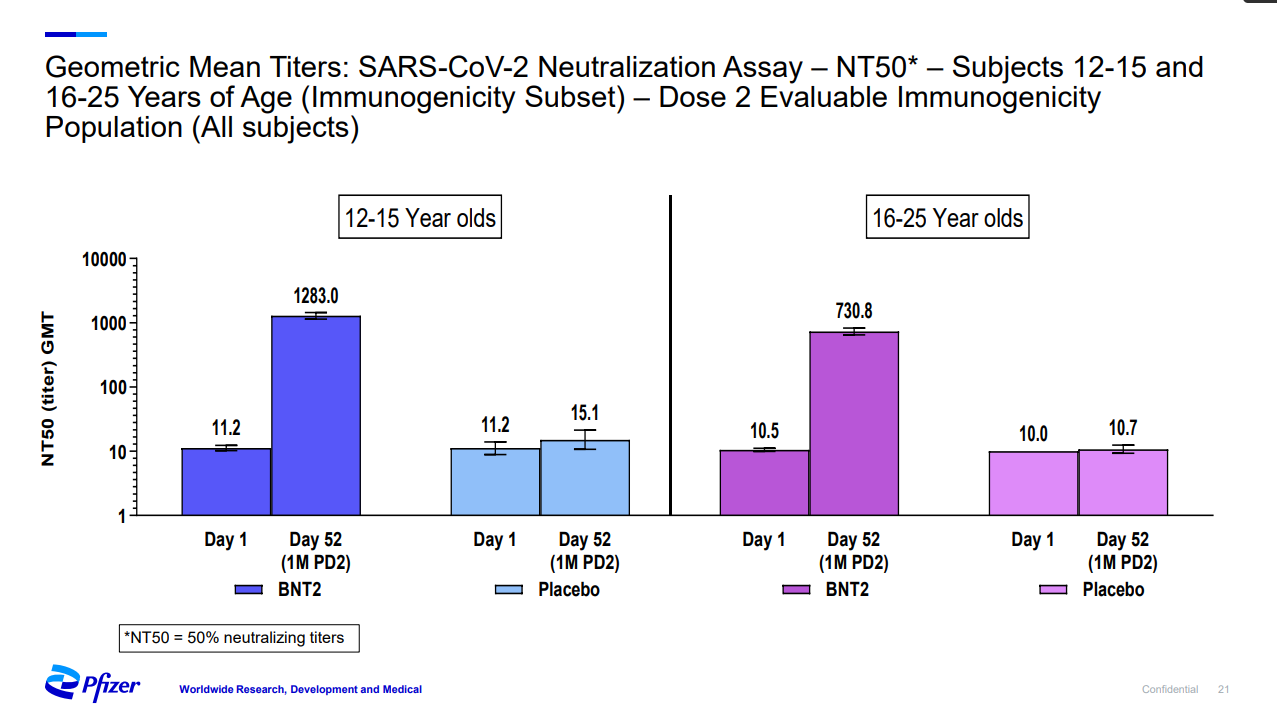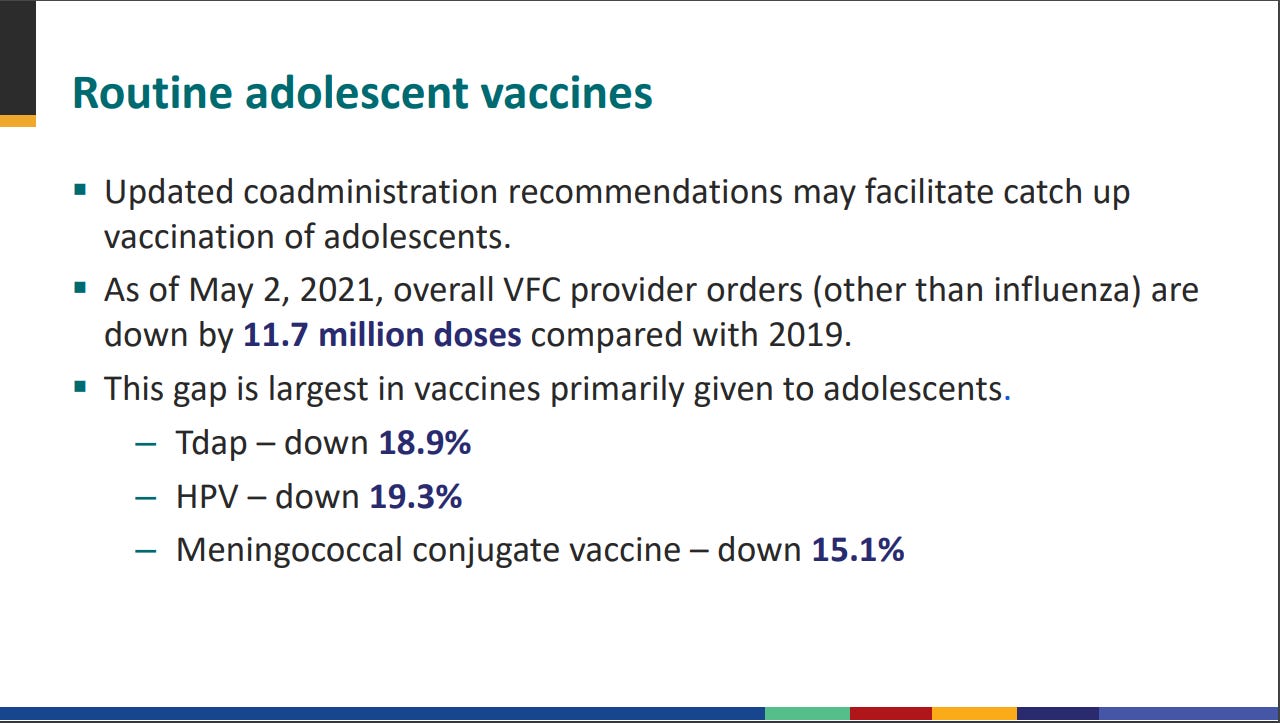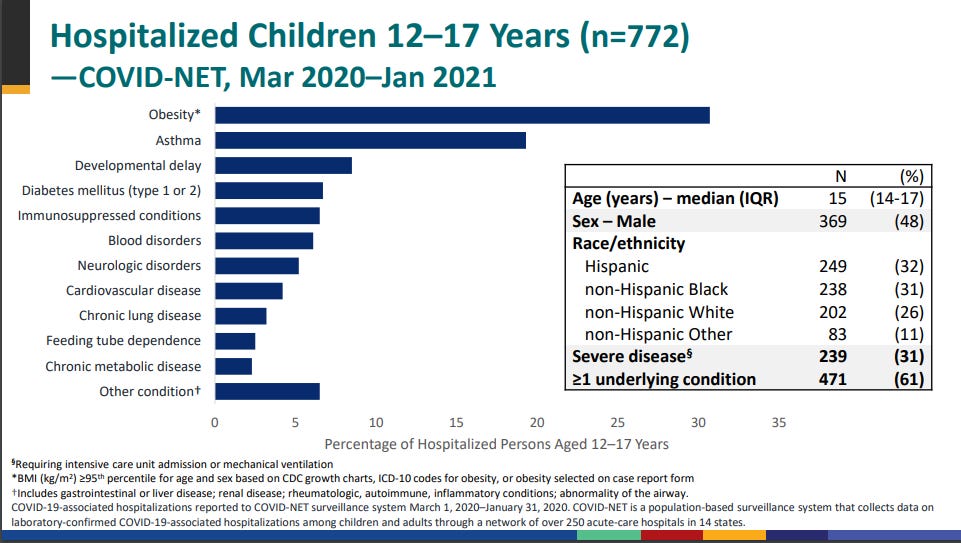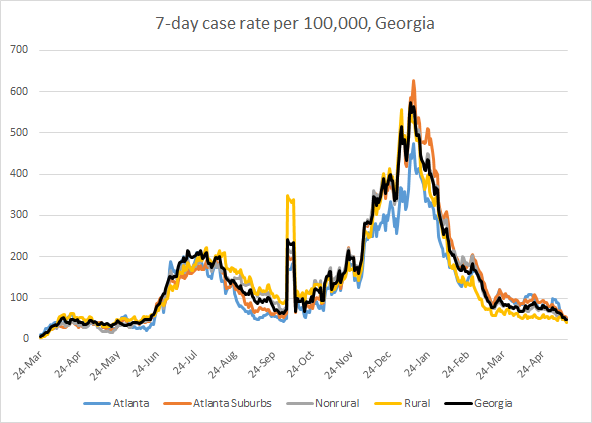Vaccines for 12-15 year olds
We have new data to discuss from the Advisory Committee on Immunization Practices (ACIP) meeting that took place at the CDC yesterday to recommend the Pfizer COVID-19 vaccine for 12-15 year olds. We’ll go over the efficacy and safety data and some additional information.
I’d also like to refer to some previous postings that may answer some questions about the Pfizer vaccine and the COVID-19 vaccines more broadly
Vaccine Q&A 5th edition with links to editions 1-4.
Clinical trial efficacy data for the Pfizer vaccine.
Efficacy
First, I want to explain how these studies were done. Pfizer did what’s called “immunobridging” analysis. What this means is the vaccine has already been proven to be efficacious in large studies of people over the age of 16. The really big thing to verify was that it was safe in the younger age group. So they compared what they found in 12-15 year olds with 16-25 year olds, the nearest age group that was studied in large numbers, expecting to find that the results would be similar if not the same. First, let’s look at how the immune response compared between vaccine recipients and placebo (received saltwater injection) among adolescents and 16-25 year olds. The graph below shows how well the antibodies each group made bound up (or neutralized) SARS-CoV-2 particles. That’s important because if the viral particles are bound up by antibodies, their spike proteins can’t dock with our cells to trigger infection. The people who received vaccine are on the left of each half of the graph. First we see day 1, when they received dose 2 and day 52, when they were one month post dose 2.
First notice what happened with the placebo. You can see that nothing really happens in this group over time and that’s what we expect, since they weren’t exposed to the spike protein that is generated with the vaccine. As a consequence, they never made antibodies against the spike protein. If we look at those that received the vaccine (see BNT2 bars on graph), we can see a dramatic increase in antibody neutralization for 16-25 year olds (purple). But the increase is even bigger for 12-15 year olds and that is really exciting and reassuring.
As far as preventing symptomatic, lab-confirmed COVID-19, the vaccine shows 100% efficacy once recipients were more than one week post 2nd dose. When they factored in people who developed COVID-19 some time between dose 1 and dose 2, the efficacy rate was 91.4%. So it’s consistent with what was observed with adults during the clinical trials.
Safety
The vaccine seems to have a very similar safety profile among 12-15 year olds as what was found for adults during the clinical trials also. Locally, at the site of the injection, pain/soreness is the most commonly reported side effect and at levels that were similar to 16-25 year olds.
The graph below shows how frequently the side effects were observed between the vaccine (top) and placebo. On the left of each section, you’re looking at 12-15 year olds. On the right of each section, it’s the 16-25 year olds. First, let’s look top to bottom comparing vaccine to placebo. We can see that the reactogenicity (the symptoms associated with an immune response) are more significant with vaccine recipients than placebo recipients, which makes sense. The most commonly reported symptoms with the vaccine were fatigue, headache, muscle pain and weakness.
If we look left to right, at 12-15 versus 16-25, we can see that the symptoms in adolescents are occurring at a similar frequency, with some variation. For example, 12-15 year olds were slightly more likely to experience fever, fatigue, headache and chills. But were less likely than 16-25 year olds to experience muscle or joint pain. Most symptoms were graded mild - moderate. Most symptoms resolved within 1-2 days.
Next, let’s look at the frequency of adverse events. Adverse events can be any symptom, including things like feeling dizzy or fainting…something that can happen with any injection vaccine but doesn’t usually require hospitalization or follow up. Serious Adverse Events (SAEs in graphs below) means any untoward medical occurence that results in death, is life threatening, requires inpatient hospitalization or prolongation of existing hospitalization, results in persistent disability/incapacity or is a congenital anomaly/birth defect. You can probably appreciate that some of these things apply more to certain age groups than others, but it’s good to use the same definition across the board. For the graphs below the top looks at 12-15 year olds and the bottom is 16-25. The dark blue bar is for the vaccine recipients and the light blue bar is for the placebo group.
Let’s begin with SAE. You can see that the proportion of vaccine recipients experiencing these events was 0.4% and this is consistent with what was observed among 16-25 year olds. It was higher than what was observed in placebo for 12-15 year olds, but the ACIP did not think this was a big concern. Adverse events in general (AE in the graph) were less frequent for 12-15 year olds than for 16-25 year olds.
So to summarize, the Pfizer vaccine appears to be even more effective in 12-15 year olds than for 16-25 year olds (see antibody neutralization assay graph) with an even better safety profile than observed for 16-25 year olds. It’s still a really good vaccine either way, but this should provide a lot of reassurance to parents who wanted to see the data before making a decision.
Additional information
The next thing to talk about are the clinical considerations for giving this vaccine to 12-15 year olds. Fainting is not uncommon after any injectable vaccine. In fact, this is the reason why you’re encouraged to sit or lay down for 15 minutes after any vaccination (this is not unique to COVID-19 vaccines).
Up until today, the ACIP has recommended against giving any other vaccines within 14 days of the COVID-19 vaccine out of an abundance of caution. However, today they have updated that guidance to say that it is okay to receive multiple vaccines (including COVID-19) on the same day or within a 14-day range. This is really, really important because during the pandemic, a lot of kids have fallen behind on their scheduled immunizations. And as we push for a semi-normal (if not fully normal) return to school in the fall, we might be in a vulnerable position for outbreaks of other vaccine-preventable disease while we’ve been distracted by COVID-19. And that is the last thing that anyone needs now.
Vaccines for Children (VFC referenced below) is a federal program to ensure that vaccines are paid for and available to children regardless of their ability to pay. So far, there have been 11.7 million fewer doses of childhood vaccines ordered this year compared to 2019 and the bulk of those are for vaccines given to adolescents including Tdap (tetanus, diphtheria and acellular pertussis), HPV (human papilloma virus, causes cervical and anal cancers), and meningococcal vaccines. When I saw the numbers presented below, they took my breath away. This is huge. So being able to vaccinate adolescents for COVID-19 and other diseases at the same time means more kids will be caught up on vaccinations by the time they return to school in the fall.
Contraindications: reasons to delay or not get a vaccine
For children or adults with MIS-C or MIS-A (multisystem inflammatory syndrome) following their COVID-19 infection, they should consider delaying vaccination until they’ve recovered from their illness and for 90 days after the date of their MIS-C/A diagnosis.
Any immediate or severe allergic reaction (i.e. anaphylaxis) after a previous dose or to a component of the COVID-19 vaccine.
If children have a history of immediate or severe allergic reaction to any vaccine or injectable therapy, they will likely be observed for 30 minutes rather than the usual 15 minutes. Previous guidance has suggested that people with this history who are seeking a vaccine should work with their immunologist or allergist and receive their dose in that clinical setting.
One piece of really compelling data that was presented at ACIP was the estimated disease burden among K-12 aged children. The graph shows percent of case incidence since the start of the pandemic for each age group and compares that to their proportion of the total population. We can see that older adults have been underperforming compared to their proportion of the population, and thank goodness. Things could have been so much worse. But people 5 - 49 years of age are outperforming their proportion of the population. In other words, they are disproportionately impacted. Some of this may be due to the perceived lower risk of COVID-19 for these age groups compared to older adults, greater willingness to take risks, etc.
The other thing is that hospitalizations are rising among the 12-17 age group.
Among children in this age group who have been hospitalized, here is the breakdown of the most frequently noted underlying conditions. However, I should note only 61% of the hospitalized 12-17 year olds had an underlying condition. The remaining 39% did not have any underlying condition. Among children who have developed the MIS-C complication after COVID-19 infection, 21% of them were in the 12-17 year group.
Not only will vaccinating 12-15 year olds protect those kids, it will also provide protection to their families at home who may have heightened risk of complications from COVID-19 infection. There’s a false narrative going around that kids can’t transmit COVID-19 to others. As much as we might wish that were true, the evidence tells us that narrative is wrong (a small sampling of the literature on this can be found here and here). Consider the study shown below that compares the odds of having COVID-19 symptoms when a child in the household is attending in-person school either full (left) or part time (right). The odds for testing positive for COVID-19 (purple dot and bar) shows an elevated risk across the board for full time in person learning. But the increase is most noticeable for kids in grades 9-12. When you’re looking at odds ratios, anything at or near one is equivalent odds (to children not attending in person learning in this case). When the odds ratio is higher than one, the chances are greater than those in virtual learning. When the odds ratio is less than one, the chances are less than those in virtual learning. I also appreciated that they asked about loss of taste and smell, which someone might brush off as something else.
Lastly, ACIP presented polling data on parent and adolescent attitudes regarding the vaccine. One of the most important things I saw was this graph that indicate where parents and adolescents feel most comfortable getting the vaccine. The clear winner in this was their regular doctor’s office. So it’s really important that we make these vaccines available in pediatrician and family physician offices. Not only are those medical professionals that the parents already have a rapport and trust, but having the vaccine available there might convert thoughtful conversations about safety and efficacy into doses administered. The next most trusted location is the child’s school, with a combined 52% of respondents choosing this option, with some wanting the parent to be present and some that didn’t need the parent to be present. These findings can be really important as we figure out the next phase of vaccinating adolescents and families.
On a federal level, they laid out a timeline from now until September for getting doses to adolescents. From now through September, they plan to augment the existing infrastructure for vaccination. But they want to work to add more providers (such as pediatricians and family physicians) who can administer the vaccines starting next month. Then in July, they want to apply school-focused strategies to make doses available. This could mean having doses available at the “meet the teacher” events before school begins in August and then following that up 3 weeks later at “open house.”
Updated CDC guidance
Today the CDC provided new guidance on what a fully vaccinated person can do. Effectively, they said that a person who is fully vaccinated can go back to pre-pandemic activities and risks. They no longer need to wear masks indoors or outdoors unless required by the business, or by federal, state or local law. I have two comments on this.
First, it makes sense for those who are fully vaccinated. The evidence continues to grow that the risk of infection (even asymptomatic infection) among people who are fully vaccinated is vanishingly small. These vaccines are really, really good at what they were designed to do. And if a person is unlikely to be asymptomatically infected, they are unlikely to unknowingly transmit to others.
Second, there’s a big assumption in this guidance that the general population is still listening and following the rules. As we all know, there is a large subset of society who downplayed the significance of this pandemic (despite hundreds of thousands of dead Americans), have ignored guidance and have been proudly NOT wearing masks this whole time to stick it to ____(choose your favorite enemy)____. I honestly sometimes look at some of the public health communication and wonder if they live in an alternate reality where everyone is on team public health and there is no disinformation or denialism. What an amazing that alternate reality must be. This updated guidance, while it makes sense for the fully vaccinated, will make it harder to distinguish between who is fully vaccinated and who is inconsiderate and reckless. This doesn’t necessarily matter for individuals who are fully vaccinated, but it does matter for situations where some but not all people are vaccinated like families with children. Or families where someone can’t be vaccinated for a medical reason, and for whom COVID-19 could kill them. I suppose I just want to remind parents and families to use common sense here. Just because a venue is full of unmasked people does not mean that they’re all vaccinated. As of today, only 28.6% of the Georgia population is fully vaccinated, a little more than one in four people. Honestly, it’s yet another reason to get vaccinated as quickly as you’re able to do so, if you haven’t been vaccinated by now. Because it will be harder to perceive who is a threat.
Georgia updates
Things are more or less cruising along for Georgia, with case and death rate dropping daily.
Testing
It was a robust day for testing in Georgia. There was a net increase of 20,441 newly reported PCR tests and 3.7% were positive. There was a net increase of 8,635 newly reported antigen tests and 3.4% were positive.
Cases
Today was a big day for cases, relative to the last four days. There was a net increase of 1114 newly reported cases with 805 identified by PCR and 309 identified by antigen test. Despite this, the 7-day case rate for the state of Georgia continues to decline (yay!!!). In fact, we haven’t seen a case rate this low since 17Jun2021, before the summer surge kicked off.
Hospitalizations
It was a mid-range day for hospital admissions. There were 78 new COVID-19 admissions and 20 ICU admissions. For three days in a row now, there have been less than 1000 COVID-19 patients currently hospitalized. This is an important milestone because we haven’t been below 1000 since last June.
There are three hospital regions in the red zone for ICU bed usage - regions A, E, and N. But it does not appear that their ICU usage is high because of COVID-19. COVID-19 patient census is in the yellow zone for region A and in the green zone for regions E and N.
Stories like this are popping up in multiple areas - the people who are being hospitalized these days have one thing in common. They’re not vaccinated. Hospitalization and ICU bed stays increase the cost of COVID care by as much as 45x and 112x higher, respectively, than if one is treated outpatient, by their primary care physician, according to an analysis by Blue Cross and Blue Shield. Hospital bills can get very big, very fast. The vaccines are safe, effective and free. As the adage says, an ounce of prevention is worth a pound of cure.
Deaths
It was a mercifully small day for deaths. There were only 15 confirmed deaths and 3 probable deaths newly reported today compared to yesterday’s totals.
References
https://www.cdc.gov/vaccines/acip/meetings/downloads/slides-2021-05-12/03-COVID-Wallace-508.pdf
https://www.cdc.gov/vaccines/acip/meetings/downloads/slides-2021-05-12/02-COVID-Perez-508.pdf
https://www.cdc.gov/vaccines/acip/meetings/downloads/slides-2021-05-12/05-COVID-Woodworth-508.pdf
https://www.cdc.gov/coronavirus/2019-ncov/vaccines/fully-vaccinated.html
https://dph.georgia.gov/covid-19-daily-status-report
https://covid-gagio.hub.arcgis.com/
https://www.wlwt.com/article/covid-19-patients-total-170-at-local-hospitals-not-a-single-one-vaccinated/36356774#
Georgia COVID-19 Updates is a free newsletter that depends on reader support. If you wish to subscribe please click the link below. There are free and paid options available.
My Ph.D. is in Medical Microbiology and Immunology. I've worked at places like Creighton University, the Centers for Disease Control & Prevention and Mercer University School of Medicine. All thoughts are my professional opinion and should not be considered medical advice.













